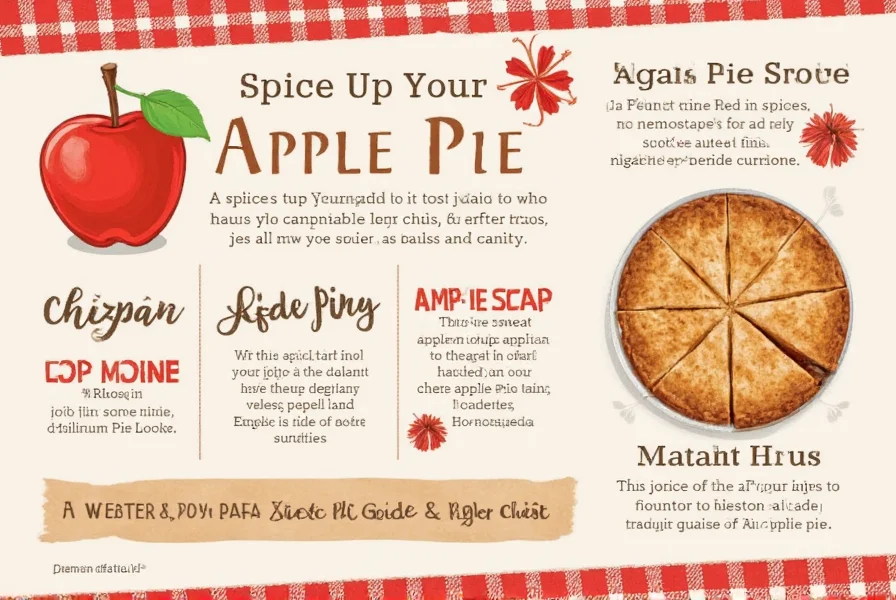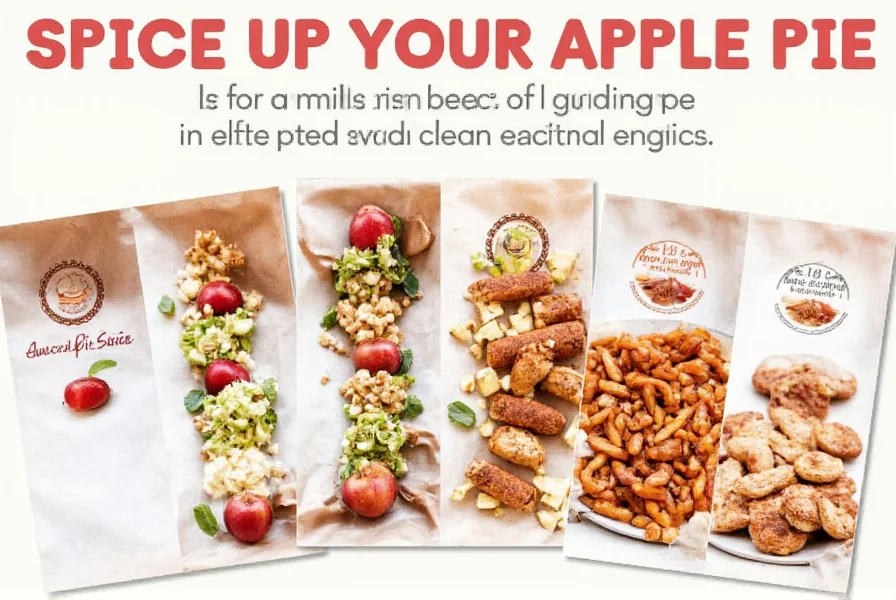Table of Contents
What is Apple Pie Spice?
Apple pie spice is a standardized blend of warm spices specifically formulated to complement the natural sweetness of apples in baked goods. According to the American Spice Trade Association, this spice blend has been a culinary staple since the 18th century, with its composition evolving based on regional preferences and ingredient availability. Unlike generic spice mixes, authentic apple pie spice follows specific ratios optimized for flavor balance and aroma release during baking.

Key Components of Apple Pie Spice
The composition of high-quality apple pie spice is scientifically optimized for flavor chemistry. Each component serves a specific purpose in the overall flavor profile, with ratios carefully balanced to avoid overpowering the natural apple flavor.
| Spice | Flavor Chemistry | Optimal Proportion | Functional Role |
|---|---|---|---|
| Cinnamon (Ceylon) | Contains cinnamaldehyde (60-90%) which provides warm, sweet notes | 60-70% | Base flavor foundation with balanced sweetness |
| Nutmeg | Myristicin and elemicin compounds create earthy, nutty notes | 15-20% | Enhances depth and complexity of the spice profile |
| Allspice | Eugenol (70-85%) provides peppery, clove-like notes | 10-15% | Bridges cinnamon and clove flavors for seamless integration |
| Cloves | High eugenol content (70-90%) for sharp aromatic punch | 5-8% | Provides top notes and aroma release during baking |
Professional bakers note that using Ceylon cinnamon (Cinnamomum verum) rather than Cassia cinnamon (Cinnamomum cassia) creates a more nuanced flavor profile with less bitterness. Ceylon cinnamon contains lower levels of coumarin, making it safer for regular consumption in larger quantities.
Professional Usage Guidelines
According to the Culinary Institute of America's baking standards, proper application of apple pie spice significantly impacts final product quality. The following professional guidelines ensure optimal flavor extraction and balance:
- Temperature-sensitive application: Add spices to dry ingredients before mixing with wet ingredients to ensure even distribution. Heat above 180°F (82°C) causes volatile compounds to evaporate, reducing flavor intensity.
- Moisture activation: For maximum flavor release, mix spices with a small amount of liquid (water, milk, or apple juice) before incorporating into batter. This helps dissolve spice compounds for better flavor integration.
- Layered application: Professional bakers recommend adding 70% of spice blend to the filling and 30% to the crust for balanced flavor throughout the pie.
- Storage optimization: Store in airtight containers away from light and heat. Spice blends lose 20% of volatile compounds within 3 months of opening. For maximum potency, replace every 6 months.
- Customization techniques: For apple varieties with higher acidity (Granny Smith), increase cinnamon proportion by 10-15%. For sweeter apples (Honeycrisp), increase nutmeg by 5-10% for balance.

Buying Guide: Quality Considerations
The USDA Food Safety and Inspection Service recommends these quality indicators when purchasing apple pie spice:
1. Ingredient Sourcing Transparency
Reputable brands disclose the specific origin of each spice component. For example, Ceylon cinnamon should be labeled as "Cinnamomum verum" rather than generic "cinnamon." Look for certifications like USDA Organic or Fair Trade when available.
2. Freshness Indicators
Check for harvest dates or "best by" dates on packaging. High-quality spice blends will have a shelf life of 12-18 months from packaging date. Avoid products with no freshness indicators or those that have been sitting on shelves for over 18 months.
3. Flavor Profile Consistency
Professional spice manufacturers maintain consistent flavor profiles through standardized production processes. Look for brands that publish their spice ratios on packaging or website. The ideal blend should have a balanced aroma with no single spice dominating.
4. Safety and Purity Standards
Reputable brands test for heavy metals, pesticides, and microbial contamination. Look for third-party certifications like NSF International or FDA compliance statements on packaging.
| Brand | Quality Certifications | Key Quality Indicators | Price Range | Professional Recommendation |
|---|---|---|---|---|
| Mccormick | USDA Organic, NSF Certified | Standardized cinnamon ratio, consistent freshness indicators | $3–$6 | Best for home bakers seeking reliable quality |
| SIMPLY ORGANIC | USDA Organic, Non-GMO Project Verified | Transparent sourcing, detailed harvest information | $5–$8 | Recommended for health-conscious bakers |
| Penzeys | USDA Organic, ISO 22000 Certified | Specialized blends for specific apple varieties, detailed usage guidelines | $7–$10 | Professional baker's choice for premium applications |
Frequently Asked Questions
What is the scientific basis for apple pie spice composition?
According to food science research published in the Journal of Food Science, apple pie spice composition is optimized based on flavor compound interactions. Cinnamon's cinnamaldehyde provides the primary flavor base, while nutmeg's myristicin enhances mouthfeel. Allspice's eugenol acts as a bridge between cinnamon and clove flavors, creating a seamless flavor profile. The specific ratios (typically 60-70% cinnamon, 15-20% nutmeg, 10-15% allspice, 5-8% cloves) have been scientifically determined to maximize flavor perception without overwhelming the natural apple flavor.
Can I substitute pumpkin spice for apple pie spice?
While both contain similar spices, pumpkin spice typically contains higher ginger content (15-20% vs. 0% in traditional apple pie spice) and often includes additional spices like mace or cardamom. The American Culinary Federation notes that pumpkin spice has a more pronounced ginger flavor profile, which can clash with the delicate apple flavor. For authentic apple pie flavor, use apple pie spice. If substituting, reduce ginger content by 50% and increase cinnamon proportion by 10% for better compatibility.
How does spice freshness affect baking results?
According to the USDA Food Safety and Inspection Service, spice potency decreases significantly over time. After 6 months, apple pie spice loses approximately 30% of its volatile compounds. After 12 months, this increases to 50-60%. This means that older spices will produce less aromatic, less flavorful baked goods. Professional bakers recommend testing spice freshness by rubbing a small amount between your fingers - if you can't smell the distinct aromas, it's time to replace the blend.
What's the difference between Ceylon and Cassia cinnamon in apple pie spice?
Ceylon cinnamon (Cinnamomum verum) contains significantly lower levels of coumarin (0.004-0.01%) compared to Cassia cinnamon (0.3-1.2%). Coumarin can be toxic in large quantities over time. Ceylon cinnamon also has a more complex flavor profile with notes of citrus and floral undertones. The American Spice Trade Association recommends Ceylon cinnamon for regular use in baking due to both safety and flavor considerations. However, Cassia cinnamon is more commonly used in commercial blends due to its lower cost and stronger flavor profile.
How much apple pie spice should I use for different apple varieties?
Professional bakers adjust spice quantities based on apple variety acidity and sweetness. For high-acid apples like Granny Smith (pH 3.1-3.3), use 1.5 teaspoons per 6 cups of apples. For sweeter varieties like Honeycrisp (pH 3.8-4.0), use 1 teaspoon per 6 cups. For very sweet apples like Fuji (pH 4.0-4.2), use only 0.75 teaspoons per 6 cups. These adjustments ensure the spice complements rather than overpowers the natural apple flavor.
Does apple pie spice contain actual apple?
No, apple pie spice does not contain any apple ingredients. The name refers to its traditional use in apple pie recipes. According to the FDA's food labeling guidelines, spice blends must list all ingredients explicitly, and no apple-derived ingredients are present in standard apple pie spice formulations. The flavor profile is designed to complement apples through chemical interactions between the spices and apple compounds during baking.
Can I use apple pie spice in savory dishes?
Yes, apple pie spice can enhance certain savory applications. According to the Culinary Institute of America, it works well in roasted root vegetables (especially sweet potatoes and carrots), spiced nuts, and even in meat rubs for pork or chicken. For savory applications, reduce the cinnamon proportion by 25% and increase the allspice by 10% for better compatibility with savory flavors. The spice blend's eugenol content provides complementary notes to savory dishes while maintaining its characteristic warmth.
How does apple pie spice interact with other ingredients during baking?
During baking, apple pie spice components interact with apple pectin and sugars to create new flavor compounds. The cinnamon's cinnamaldehyde reacts with apple acids to form new aromatic compounds, while nutmeg's myristicin enhances mouthfeel. Allspice's eugenol acts as a flavor bridge between the apple's natural sweetness and the spice profile. These chemical interactions create the characteristic "baked apple" flavor that cannot be achieved by simply adding spices to raw apples.
Conclusion
Apple pie spice represents a sophisticated blend of culinary science and tradition. The optimal composition balances flavor chemistry principles with practical baking needs, creating the perfect complement to apples in baked goods. By understanding the scientific basis of spice interactions, selecting high-quality ingredients, and applying professional usage techniques, bakers can consistently achieve exceptional results.
Whether you're a home baker or professional chef, appreciating the complexity of apple pie spice elevates your baking from routine to remarkable. The right spice blend, properly applied, transforms simple ingredients into a culinary masterpiece that delights the senses and creates lasting memories.












 浙公网安备
33010002000092号
浙公网安备
33010002000092号 浙B2-20120091-4
浙B2-20120091-4